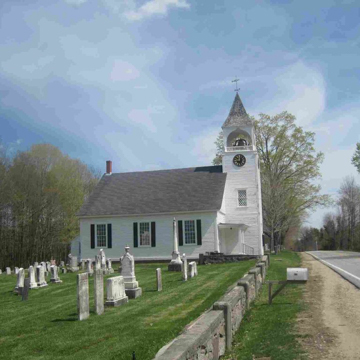You are here
South Barnstead Congregational Church
Originally a simple wooden vernacular building erected in c. 1820 as a Free Will Baptist church, it became the home of an Adventist church about 1850 and a Congregational church during the 1890s. The southwest-facing front facade features a central, square tower with side porches and an open belfry and broken pyramidal roof dating from 1912, when it was owned by the South Barnstead Congregational Church. This late “Victorianization” of the rectangular plan structure created a pleasant blend of contrasting horizontal and vertical lines, enhanced by the picturesque wooded setting and adjacent cemetery. Standard vernacular details include: wall sillboards, cornerboards and a shallow gable cornice; box cornices with moldings and friezes; and large, multi-pane, double-sash side windows with louvered shutters. Originally called the Clark Meeting House, the church is arguably South Barnstead’s most important building.
On the southwest side of New Hampshire 126, just north of the village center, is the historic South Barnstead Schoolhouse, today occupied by the Christian Fellowship. Also a plain vernacular building, it was erected in the mid-nineteenth century and follows the rectangular plan typical of rural New Hampshire schoolhouses of this period. Its most prominent feature is the front gable, ornate open belfry with broken pyramidal roof, very similar to the belfry of the Congregational church. In recent years, the schoolhouse structure has been enlarged by the addition of a south wing with compatible stylistic details. A relatively new front doorway with side lights and a broken pediment is awkward in its proportions and detracts from the otherwise pleasant ambience of the building.
Writing Credits
If SAH Archipedia has been useful to you, please consider supporting it.
SAH Archipedia tells the story of the United States through its buildings, landscapes, and cities. This freely available resource empowers the public with authoritative knowledge that deepens their understanding and appreciation of the built environment. But the Society of Architectural Historians, which created SAH Archipedia with University of Virginia Press, needs your support to maintain the high-caliber research, writing, photography, cartography, editing, design, and programming that make SAH Archipedia a trusted online resource available to all who value the history of place, heritage tourism, and learning.

